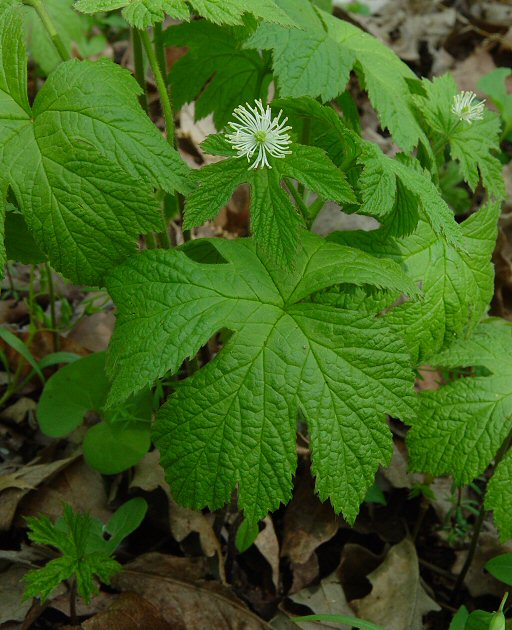Hydrastis canadensis L.
Goldenseal

Native
CC = 6
CW = 5
MOC = 68
© DETenaglia
Hydrastis canadensis L.Goldenseal | |
 |
Native CC = 6 CW = 5 MOC = 68 |
© DETenaglia |
|
Family - Ranunculaceae Habit - Perennial forb with thick, yellow, creeping, usually branched rhizomes. Stems - Ascending, to 30 cm, moderately pubescent with short, fine, spreading hairs.
Leaves - Basal and alternate. Basal leaf one, often small and scalelike or withering early when subtending fertile stems, well-developed when no fertile stem is produced, long-petiolate. Stem leaves 2, alternate near the stem tip, relatively short-petiolate. Leaf blades 2-6 cm long and 3-10 cm wide at flowering, developing to 12-25 cm wide at fruiting, palmately 5-9-lobed, broadly heart-shaped or kidney-shaped to nearly circular, the base deeply cordate, the lobes variously oblong-elliptic to elliptic, ovate, or somewhat rhombic, tapered to sharply pointed tips, the margins otherwise sharply and irregularly jagged-toothed or-lobed, the upper surface glabrous or nearly so, the undersurface finely hairy along the veins. Surfaces strongly rugose on young leaves, becoming mostly smooth with age. Upper leaf sessile, typically smaller than lower leaf.
Inflorescence - Solitary flowers at stem tips, the stalk 5-35 mm long, produced as the leaves develop. Flowers - actinomorphic, perfect, apetalous. Sepals 3, 3.5-7.0 mm long, ovate to oval or elliptic, rounded or bluntly pointed at the tip, plane, green to creamy white, shed before the stamens and pistils become functional. Stamens numerous, showy, the anthers yellow. Filaments white, glabrous, thicker at apex than base, to 1 mm thick, 8-9 mm long, curved. Staminodes absent. Pistils 5-15, each with 2 ovules, the style rather short.
Fruits - Dense, globose aggregates of 5-15 berries, the clusters 15-26 mm in diameter, the individual berries 5-8 mm long, more or less globose to more commonly distended and/or somewhat flattened by adjacent berries, juicy, the outer layer thin, red, smooth or finely pebbled, not veiny, tipped with a peglike beak, this 1-2 mm long, straight, but usually somewhat angled. Seeds 1 or 2 per berry, 2.5-4.5 mm long, ellipsoid, the surface smooth, black, shiny. Receptacle not enlarged at fruiting.
Flowering - April - May. Habitat - Bottomland and mesic forests, streambanks, bases of bluffs, ravines. Origin - Native to the U.S. Lookalikes - None when in flower or fruit. Other info. - This is a fairly common plant in rich woodlands in the eastern half of Missouri. Missouri lies at the western edge of the plant's natural range, which extends mostly eastward and into New England. Fertile plants are unmistakable with their unique flowers and fruit clusters. Vegetative plants can be recognized by leaf shape, with a little practice. The leaves are highly textured when young, less so when mature. Photographs taken at the Current River Conservation Area, Ripley County, MO., 7-4-01, and at Whetstone Conservation Area, Callaway County, MO., 4-27-04 (DETenaglia); also at Weldon Spring Conservation Area, St. Charles County, MO, 6-23-2007, Rockwoods Reservation, St. Louis County, MO, 4-8-2010, Little Lost Creek Conservation Area, Warren County, MO, 4-23-2014, Young Conservation Area, Jefferson County, MO, 4-22-2015 and 4-12-2017, and Washington State Park, Washington County, MO, 4-18-2016 (SRTurner). |